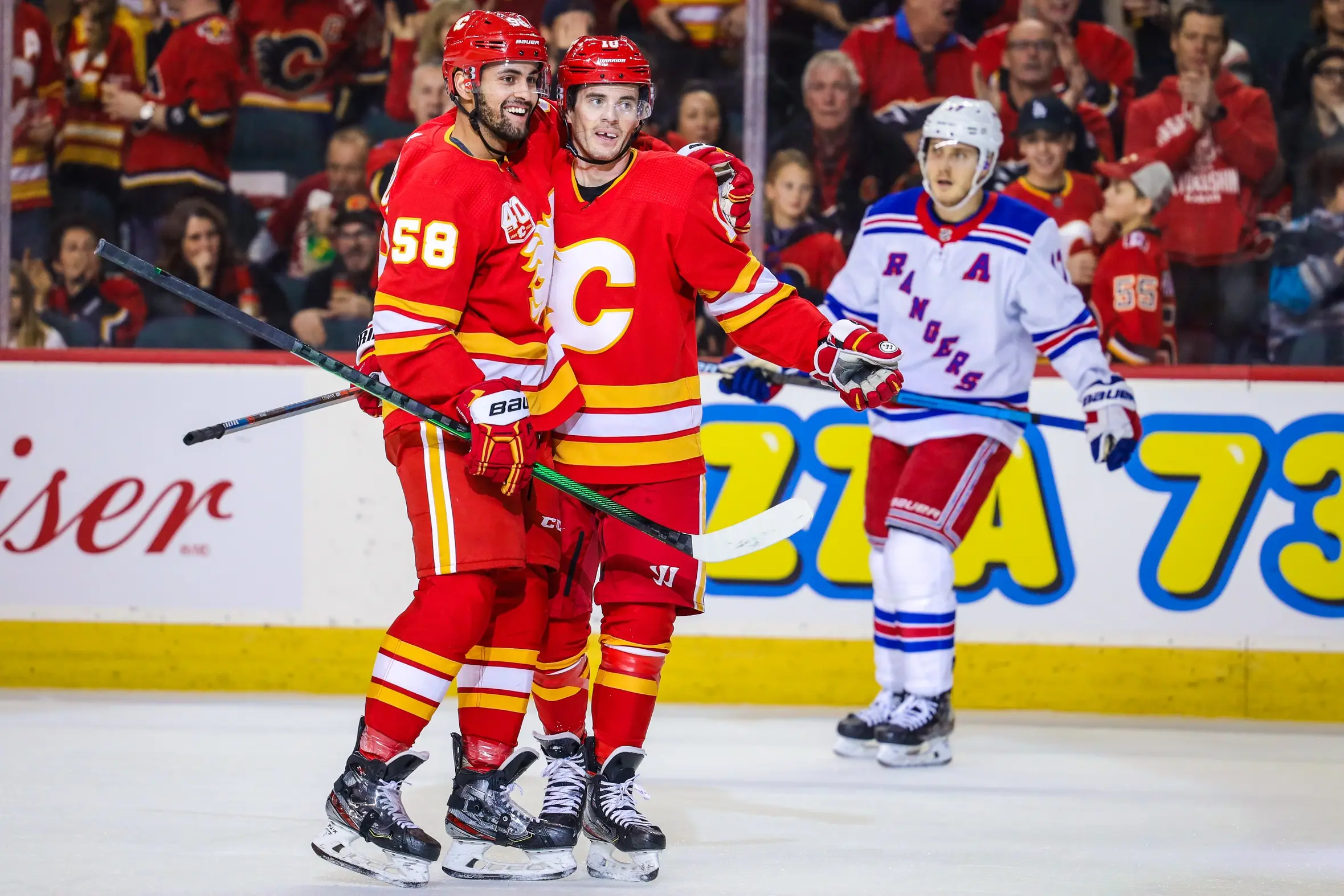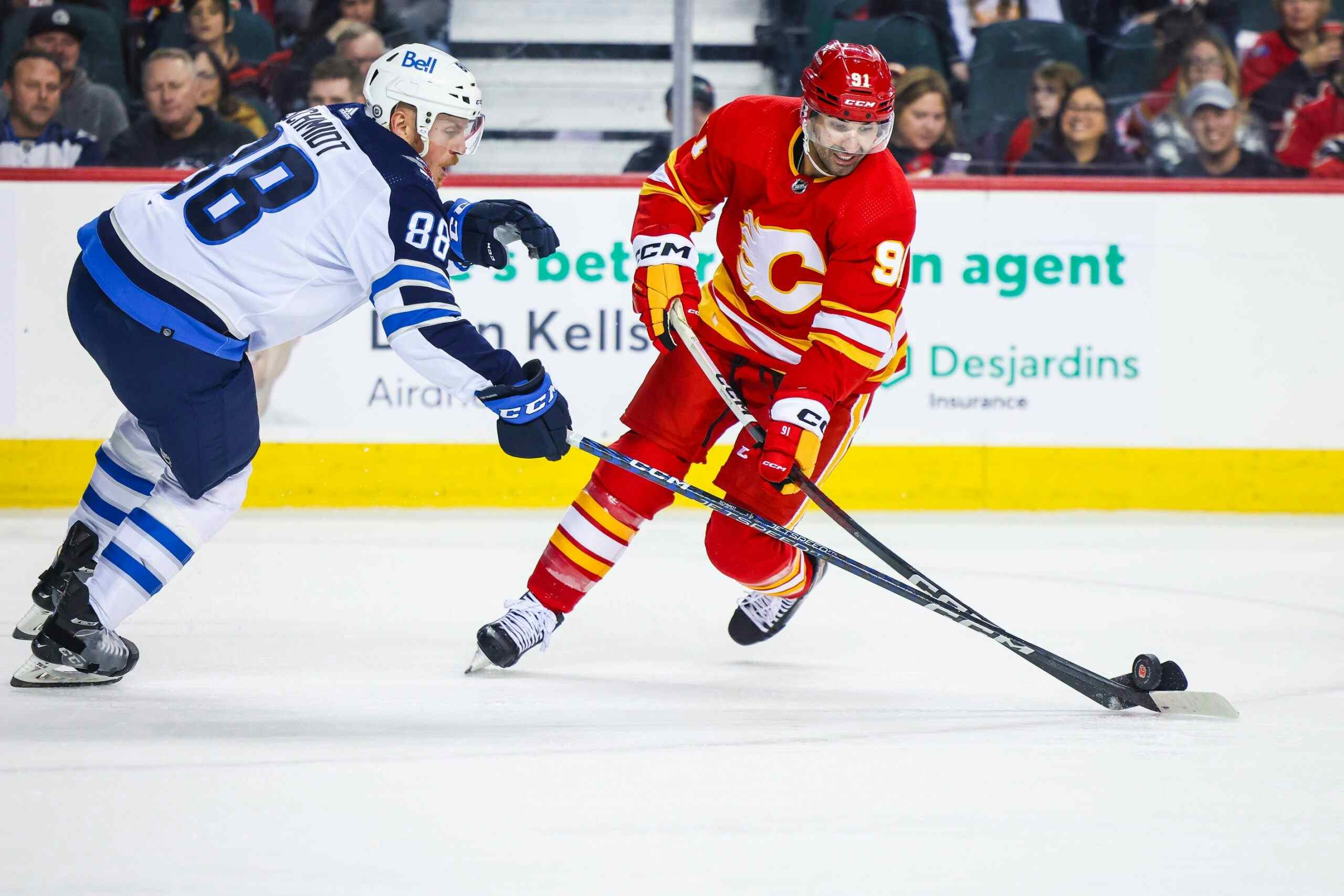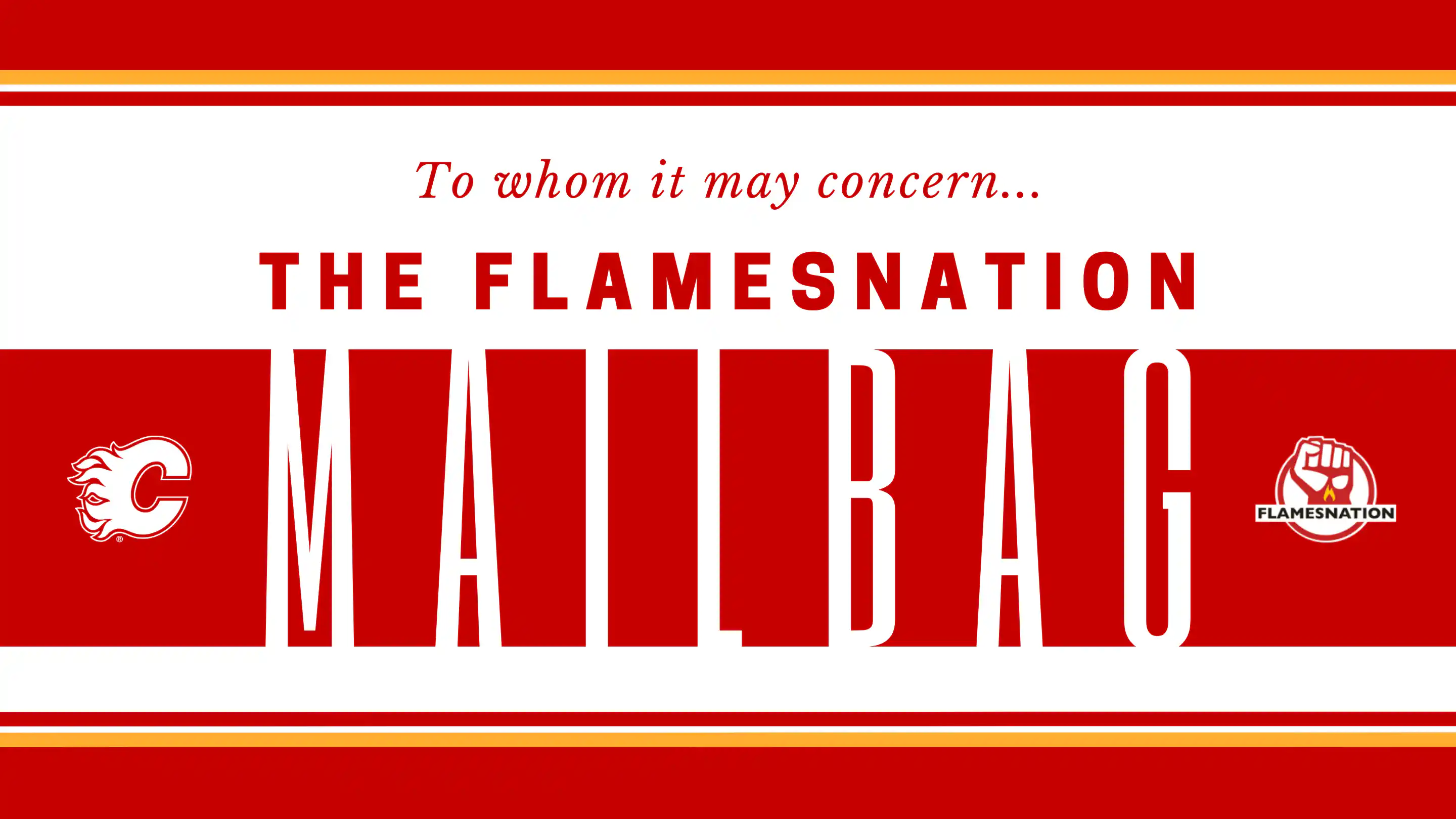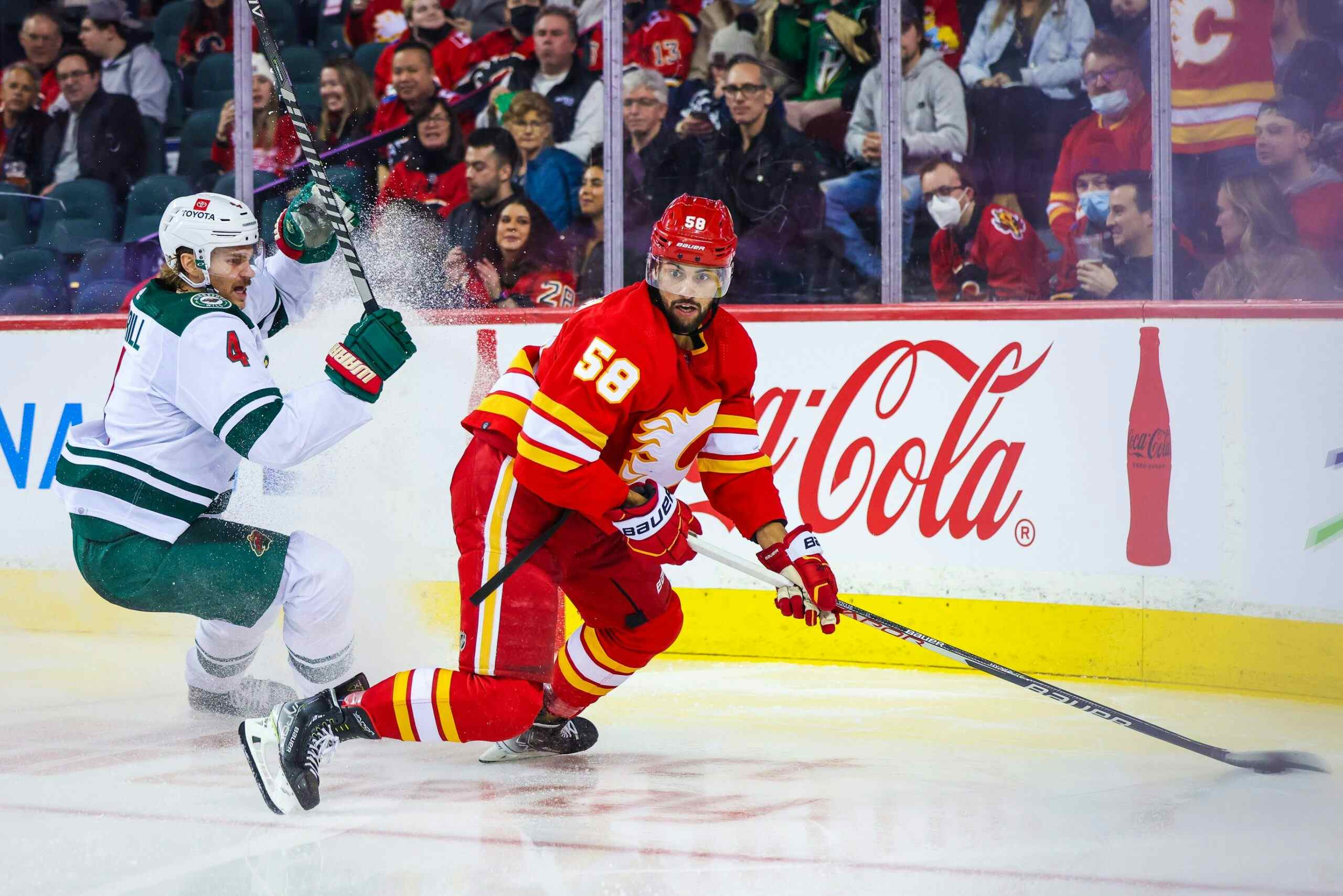Flames are worse than last season, but a little bit better under Geoff Ward

By Ryan Pike
4 years agoThe @Calgary Flames were a superb hockey team in 2018-19. Their 2019-20 edition has, through 53 games, been consistently inconsistent. Some games they’re really good. Some games they are distinctly un-good.
On Saturday after morning skate, I dug into the game-by-game scoring chance and high danger scoring chance differentials – looking only at five-on-five play – and tweeted some trends that emerged compared to recent seasons.
One of the questions that came out of those trend discussions was simply: what’s going on? The Flames are a pretty good team (on paper) coming off a stellar 2018-19 regular season. Why are they so mediocre in terms of both puck possession and meaningful possession?
I decided to dig into this a bit at the individual player level and see if any trends emerged – as in, where any particular players dragging them down?
(All data here is from our friends at Natural Stat Trick and we cut off before Saturday’s game; we’re looking exclusively at the Per 60 scoring chance (SC) and high danger chance (HDC) differentials to control for ice time differences and focus just on what direction chances are going.)
The forwards
| Player | 2018-19 SC Diff/60 | 2019-20 SC Diff/60 | Change | 2018-19 HDC Diff/60 | 2019-20 HDC Diff/60 | Change |
| Gaudreau | 3.27 | -1.44 | -4.71 | 1.80 | -1.43 | -3.23 |
| Tkachuk | 7.04 | 2.78 | -4.26 | 1.67 | 0.25 | -1.42 |
| Backlund | 5.13 | -1.16 | -6.29 | 0.94 | 0.00 | -0.94 |
| Monahan | 2.21 | -3.58 | -5.79 | 1.26 | -1.08 | -2.34 |
| Lindholm | 4.47 | 0.43 | -4.04 | 2.01 | -1.03 | -3.04 |
| Mangiapane | 8.14 | 5.54 | -2.60 | 4.14 | 1.39 | -2.75 |
| Dube | -7.26 | -4.89 | +2.37 | -2.07 | 0.75 | +2.82 |
| Ryan | 5.07 | 0.68 | -4.39 | 2.73 | -0.10 | -2.83 |
| Bennett | 4.92 | 3.70 | -1.22 | 2.46 | 1.33 | -1.13 |
| Frolik | 5.39 | 1.20 | -4.19 | 1.32 | 0.30 | -1.02 |
| Jankowski | 3.78 | 1.79 | -1.99 | 0.22 | 0.36 | +0.14 |
(It’s not an apples-to-apples comparison, but @James Neal for @Milan Lucic is a +0.33 SC and +0.87 HDC improvement.)
So, a lot to unpack here. Who got worse year-over-year among the Flames’ regular forwards? Everybody except @Dillon Dube (and @Mark Jankowski, whose high danger chances were basically unchanged.) The takeaway here is this: every Flames regular forward is worse at creating chances (or suppressing them) than they were a year ago, despite not significantly changing their personnel, deployments, or systems.
This is spooky.
The defenders
| Player | 2018-19 SC Diff/60 | 2019-20 SC Diff/60 | Change | 2018-19 HSC Diff/60 | 2019-20 HSC Diff/60 | Change |
| Hanifin | 2.68 | -1.47 | -4.15 | 1.58 | 0.93 | -0.65 |
| Hamonic | 6.03 | -1.97 | -8.00 | 2.84 | 1.21 | -1.63 |
| Giordano | 6.90 | 2.10 | -4.80 | 1.76 | 0.68 | -1.08 |
| Brodie | 4.91 | 0.95 | -3.96 | 0.91 | -0.16 | -1.07 |
| Andersson | 1.15 | 3.87 | +2.72 | 0.61 | 0.44 | -0.17 |
| Stone | -6.98 | -11.71 | -4.73 | -5.71 | -5.66 | +0.05 |
| Kylington | -2.19 | 1.04 | +3.23 | -0.52 | -1.63 | +1.11 |
Very similar pattern here: for both regular and high-danger chances, basically all the regulars got worse. The notable exceptions are @Rasmus Andersson (improved in regular chances), Oliver Kylington (improved in regular and high dangers), and Michael Stone (worse in regular but unchanged in high dangers). The only regular conclusion on the blueline is the third pairing group is improved but the top two pairings are worse than they were a year ago.
Again: spooky.
In-season differences?
I discussed my findings with some colleagues prior to Saturday’s game and it was noted to me that it would be worth splitting this season in half, as the Flames changed coaches midway through the schedule.
Here’s the in-season breakdown:
Forwards
| Player | Peters SC Diff/60 | Ward SC Diff/60 | Change | Peters HDC Diff/60 | Ward HDC Diff/60 | Change |
| Gaudreau | -1.63 | -1.21 | +0.42 | -2.52 | -0.17 | +2.35 |
| Tkachuk | 0.95 | 4.85 | +3.90 | -0.79 | 1.44 | +2.23 |
| Backlund | 2.02 | -4.75 | -6.77 | -0.78 | 0.87 | +1.65 |
| Monahan | -4.25 | -2.82 | +1.43 | -2.52 | 0.53 | +3.05 |
| Lindholm | -1.68 | 2.64 | +4.32 | -2.36 | 0.35 | +2.71 |
| Mangiapane | 6.67 | 4.52 | -2.15 | 1.46 | 1.31 | -0.15 |
| Dube | -2.04 | -5.53 | -3.49 | -2.04 | 1.38 | +3.42 |
| Ryan | 1.41 | 0.00 | -1.41 | -0.61 | 0.38 | +0.99 |
| Bennett | 1.67 | 6.01 | +4.34 | 0.00 | 2.85 | +2.85 |
| Frolik | -1.11 | 5.89 | +7.00 | -1.35 | 3.63 | +4.98 |
| Jankowski | 3.92 | -0.79 | -4.71 | 1.31 | -0.78 | -2.09 |
It’s worth noting that aside from a few ice time tweaks, Geoff Ward largely uses everyone in the same way Bill Peters did. So how has player performance changed? Well, everybody (except for Jankowski, who’s worse, and Mangiapane, who’s unchanged) is better in the high-danger areas, while results are a bit more mixed in the more general scoring chances numbers.
Everyone has worse numbers than they did a year ago, when the Flames were the Harlem Globetrotters, but while the Bill Peters 2019-20 Flames were pretty lousy, the Geoff Ward version are an above average hockey team in terms of generating and suppressing high danger scoring chances.
Defense
| Player | Peters SC Diff/60 | Ward SC Diff/60 | Change | Peters HSC Diff/60 | Ward HSC Diff/60 | Change |
| Hanifin | -2.30 | -0.56 | +1.74 | 0.00 | 1.94 | +1.94 |
| Hamonic | -1.76 | -2.15 | -0.39 | 1.12 | 1.29 | +0.17 |
| Giordano | 1.72 | 2.49 | +0.77 | -0.53 | 1.94 | +2.47 |
| Brodie | -0.37 | 1.96 | +2.33 | -0.91 | 0.42 | +1.33 |
| Andersson | 5.92 | 1.55 | -4.37 | 0.13 | 0.78 | +0.65 |
| Stone | -7.90 | -17.26 | -9.36 | -6.25 | -4.79 | +1.46 |
| Kylington | 1.38 | 0.71 | -0.67 | -3.00 | -0.23 | +2.77 |
A Similar pattern on the blueline: everyone’s high danger numbers have improved under Ward (Hamonic’s numbers are close to unchanged), while the regular chances are a bit more noisy and less distinctive.
Summing it up
The Flames this season are, to a man, worse than they were a season ago. Collectively, they are allowing more scoring chances (high danger and otherwise) and generating fewer. On the aggregate, they’re hovering around break-even after being well above that level a season ago. This manifests itself in the individual numbers – with a handful of exceptions, primarily their younger players, everybody has performed poorly compared to a season in terms of scoring chance numbers.
That said: the Flames – almost every single player – are appreciably better in this respect under interim coach Ward. If they can find some damn consistency, they could finally turn a corner and get some traction in the standings.
Recent articles from Ryan Pike





